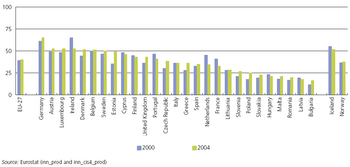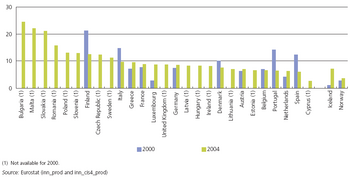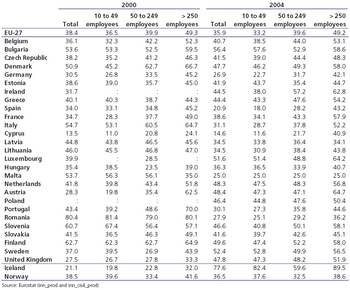Archive:Innovation statistics
- Data from September 2007, most recent data: Further Eurostat information, Main tables and Database.
This article looks at the state of innovation in the European Union (EU) by presenting data on where it is done, how many enterprises are involved, what types of entreprises they are and the share taken by innovative products and services. By placing competitiveness at the heart of the EU political agenda, the reinvigorated Lisbon process aims to make Europe a more attractive place to invest, by boosting entrepreneurial initiative and creating a productive environment where innovation capacity can grow and develop.
Main statistical findings
According to the fourth Community innovation survey (CIS4), the proportion of enterprises undertaking innovation activities increased slightly compared to the results from the earlier CIS3. Some 40 % of the EU-27’s enterprises were innovative in 2004, compared to 39 % in 2000 (see Figure 1). This slight increase in innovation activity was present in the majority of countries, with Ireland, Cyprus, Finland, Portugal, the Netherlands, France, Hungary, Latvia and Iceland the only exceptions - reporting a lower propensity to innovate in 2004.
Germany showed the greatest propensity to innovate in 2004, with more than two thirds of all German enterprises having some form of innovation activity. At the other end of the spectrum, Bulgaria, Latvia and Romania each reported that fewer than one in five enterprises were engaged in innovative activities.
A breakdown by enterprise size class shows that large enterprises (with 250 and more employees) were more inclined to introduce new or improved products to the market (see Table 1). Almost half of all large innovative enterprises did so in the EU-27 in 2004, compared to less than 40 % of medium-sized enterprises (with 50 to 249 employees) and only around one-third of small enterprises(employing 10 to 49 people).
New or significantly improved products contributed a relatively small share of total turnover among innovative enterprises in 2004, below the threshold of 10 % in most Member States (see Figure 2); these products did however account for more than 20 % of sales in Malta and Slovakia.
Data sources and availability
The fourth Community innovation survey (CIS4) collects information about both product and process innovation and organisational and marketing innovation. The legal basis for the collection of these statistics is Commission Regulation (EC) 1450/2004 of 13 August 2004 implementing Decision No 1608/2003/EC of the European Parliament and of the Council concerning the production and development of Community statistics on innovation.
The survey covers areas such as new or significantly improved goods or services and the introduction of new or significantly improved processes, logistics or distribution methods. It also provides information on the characteristics of innovation activity at the enterprise level, thus creating a better understanding of the innovation process and the effects of innovation on the economy.
For the purpose of the Community innovation survey (CIS) an innovation is defined as a new or significantly improved product (good or service) introduced to the market, or the introduction within an enterprise of a new or significantly improved process. Innovations are based on the results of new technological developments, new combinations of existing technology, or the utilisation of other knowledge acquired by the enterprise. Such innovations may be developed by the innovating enterprise or by another enterprise. However, purely selling innovations wholly produced and developed by other enterprises is not included as an innovation activity, nor is introducing products with purely aesthetic changes. Innovations should be new to the enterprise concerned: for product innovations they do not necessarily have to be new to the market and for process innovations the enterprise does not necessarily have to be the first one to have introduced the process.
Enterprises with innovation activity cover all types of innovator including product innovators, process innovators, as well as enterprises with only on-going and/or abandoned innovation activities. The proportion of enterprises with innovation activity is also referred to as the propensity to innovate.
In terms of comparability of data between the different surveys, Eurostat made particular improvements for comparison between the third and fourth innovation surveys, which were based on similar survey methodology, target populations, survey questionnaires and definitions of innovation. CIS4 was carried out in all EU Member States, as well as Iceland and Norway. Data is also available broken down by enterprise size class.
Context
By placing competitiveness at the heart of the European political agenda, the reinvigorated Lisbon process aims to make Europe a more attractive place to invest, by boosting entrepreneurial initiative and creating a productive environment where innovation capacity can grow and develop. With this in mind, on 29 October 2006, the European Parliament and the Council adopted a Decision 1639/2006/CE establishing a competitiveness and innovation framework programme (CIP) for the period 2007-2013 .
Education is seen as a key to developing an innovation-orientated society, through developing entrepreneurial skills, as well as literacy, scientific and mathematical competence, languages and digital literacy. Many policy makers express concern at the falling number of science and technology graduates and a lack of mobility between universities and industry.
Another element that is often considered as being important for the development of an innovative society is the regulatory environment. More specifically, the success of innovation is considered by many to depend on the rapid adoption of new technological standards and the protection of intellectual property. Policy developments in this field include a [[European Commission]] proposal for the adoption of a Community-wide patent system (see Patent statistics), while Directive 2004/48/EC of the European Parliament and of the Council covers the enforcement of intellectual property rights; this is in the process of being revised and has reached the stage of an amended European Commission proposal for a Directive on criminal measures aimed at ensuring the enforcement of intellectual property rights.
Further Eurostat information
Publications
- Science, technology and innovation in Europe
- Innovation in Europe – results for the EU, Iceland and Norway
- Science, technology and innovation in Europe – 2008 edition pocketbook
Main tables
- Science and technology, see:
- Community innovation survey
- Turnover from innovation
- Effects of innovation on material and energy efficiency
Database
- Science and technology, see:
- Community innovation survey
- Results of the second community innovation survey
- Results of the third community innovation survey
- Results of the fourth community innovation survey
- Results of the community innovation survey 2006
- Results of the first community innovation light survey - CIS light
External links
- European Commission - Competitiveness and Innovation Framework Programme (CIP)
- OECD - Science and innovation - Statistics
- Regional Innovation Scoreboard (RIS) 2009


